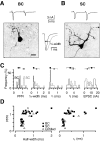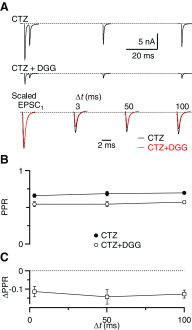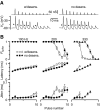A low-affinity antagonist reveals saturation and desensitization in mature synapses in the auditory brain stem
- PMID: 20107122
- PMCID: PMC2853296
- DOI: 10.1152/jn.00751.2009
A low-affinity antagonist reveals saturation and desensitization in mature synapses in the auditory brain stem
Abstract
Postsynaptic receptor desensitization has been observed to contribute to depression in immature synapses. However, it is not clear whether desensitization persists and causes depression in mature synapses. We investigate this issue at the endbulb of Held, the synapse made by auditory nerve (AN) fibers onto bushy cells (BCs) of the anteroventral cochlear nucleus, where depression could influence the processing of sound information. Experiments using cyclothiazide (CTZ) have implicated desensitization in endbulbs from postnatal day 16 (P16) to P21 mice, but application of γ-D-glutamylglycine (DGG) did not reveal desensitization in endbulbs >P22. To reconcile these findings, we have studied the effects of both CTZ and DGG on endbulbs from P5 to P40 CBA/CaJ mice. In paired-pulse protocols, both CTZ and DGG reduced depression in all ages at intervals <10 ms, consistent with their effects preventing desensitization. However, DGG increased depression at intervals >20 ms, consistent with DGG's use to prevent saturation. DGG application revealed receptor saturation even under conditions of very low release probability. Preventing desensitization by CTZ occluded the effects of DGG on desensitization and revealed the effects of saturation at short intervals. We developed an approach to separate DGG's effect on saturation from its effect on desensitization, which showed that desensitization has an impact during bursts of auditory nerve activity. Dynamic-clamp experiments indicated that desensitization can reduce BC spike probability and increase latency and jitter. Thus desensitization may affect sound processing in the mature auditory system.
Figures









Similar articles
-
Endbulb synaptic depression within the range of presynaptic spontaneous firing and its impact on the firing reliability of cochlear nucleus bushy neurons.Hear Res. 2010 Dec 1;270(1-2):101-9. doi: 10.1016/j.heares.2010.09.003. Epub 2010 Sep 17. Hear Res. 2010. PMID: 20850512 Free PMC article.
-
Context-dependent effects of NMDA receptors on precise timing information at the endbulb of Held in the cochlear nucleus.J Neurophysiol. 2009 Nov;102(5):2627-37. doi: 10.1152/jn.00111.2009. Epub 2009 Sep 2. J Neurophysiol. 2009. PMID: 19726731 Free PMC article.
-
Impact of synaptic depression on spike timing at the endbulb of Held.J Neurophysiol. 2009 Sep;102(3):1699-710. doi: 10.1152/jn.00072.2009. Epub 2009 Jul 8. J Neurophysiol. 2009. PMID: 19587324 Free PMC article.
-
The ion channels and synapses responsible for the physiological diversity of mammalian lower brainstem auditory neurons.Hear Res. 2019 May;376:33-46. doi: 10.1016/j.heares.2018.12.011. Epub 2018 Dec 26. Hear Res. 2019. PMID: 30606624 Review.
-
Short-term plasticity and auditory processing in the ventral cochlear nucleus of normal and hearing-impaired animals.Hear Res. 2011 Sep;279(1-2):131-9. doi: 10.1016/j.heares.2011.04.018. Epub 2011 May 10. Hear Res. 2011. PMID: 21586317 Free PMC article. Review.
Cited by
-
Calretinin-Expressing Synapses Show Improved Synaptic Efficacy with Reduced Asynchronous Release during High-Rate Activity.J Neurosci. 2022 Mar 30;42(13):2729-2742. doi: 10.1523/JNEUROSCI.1773-21.2022. Epub 2022 Feb 14. J Neurosci. 2022. PMID: 35165172 Free PMC article.
-
Munc13-1 is a Ca2+-phospholipid-dependent vesicle priming hub that shapes synaptic short-term plasticity and enables sustained neurotransmission.Neuron. 2021 Dec 15;109(24):3980-4000.e7. doi: 10.1016/j.neuron.2021.09.054. Epub 2021 Oct 26. Neuron. 2021. PMID: 34706220 Free PMC article.
-
Activation of extrasynaptic NMDARs at individual parallel fiber-molecular layer interneuron synapses in cerebellum.J Neurosci. 2013 Oct 9;33(41):16323-33. doi: 10.1523/JNEUROSCI.1971-13.2013. J Neurosci. 2013. PMID: 24107963 Free PMC article.
-
Morphological characterization of bushy cells and their inputs in the laboratory mouse (Mus musculus) anteroventral cochlear nucleus.PLoS One. 2013 Aug 26;8(8):e73308. doi: 10.1371/journal.pone.0073308. eCollection 2013. PLoS One. 2013. PMID: 23991186 Free PMC article.
-
The ubiquitous nature of multivesicular release.Trends Neurosci. 2015 Jul;38(7):428-38. doi: 10.1016/j.tins.2015.05.008. Epub 2015 Jun 19. Trends Neurosci. 2015. PMID: 26100141 Free PMC article. Review.
References
-
- Bellingham MC, Walmsley B. A novel presynaptic inhibitory mechanism underlies paired pulse depression at a fast central synapse. Neuron 23: 159–170, 1999. - PubMed
-
- Brawer JR, Morest DK. Relations between auditory nerve endings and cell types in the cat's anteroventral cochlear nucleus seen with the Golgi method and Nomarski optics. J Comp Neurol 160: 491–506, 1975. - PubMed
-
- Brawer JR, Morest DK, Kane EC. The neuronal architecture of the cochlear nucleus of the cat. J Comp Neurol 155: 251–300, 1974. - PubMed
-
- Chen C, Blitz DM, Regehr WG. Contributions of receptor desensitization and saturation to plasticity at the retinogeniculate synapse. Neuron 33: 779–788, 2002. - PubMed
Publication types
MeSH terms
Substances
Grants and funding
LinkOut - more resources
Full Text Sources
Miscellaneous

